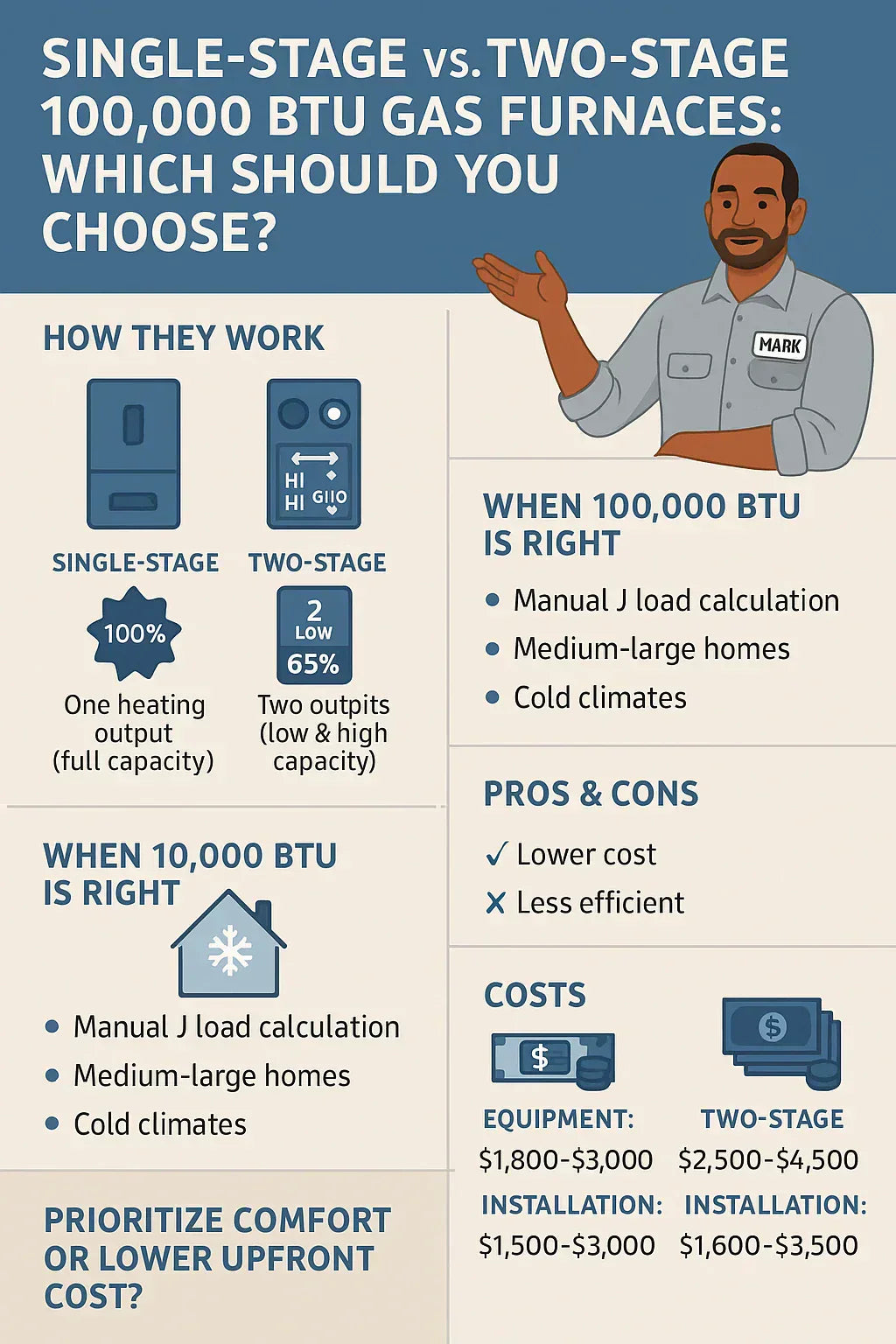1. 🏠 Why This Decision Matters
When I first started looking into replacing my furnace, I assumed that “100,000 BTUs” was all I needed to care about. But when the salesperson asked if I wanted single-stage or two-stage, I realized I had homework to do.
A 100,000 BTU gas furnace is a workhorse—perfect for medium-to-large homes in colder climates. But how it delivers that heat can mean the difference between:
-
Even, comfortable heat all day, or
-
Hot/cold temperature swings and noisy blasts of air.
And with 2025’s shift toward R-32-compatible HVAC systems, staging decisions can also affect your summer cooling performance.
2. ⚙️ How Furnace Staging Works
Think of staging like your car’s gas pedal.
-
Single-stage furnace: Always runs at full throttle.
-
Two-stage furnace: Can run at a lower speed most of the time and kick into high only when needed.
In technical terms:
-
Single-stage: One fixed gas valve setting = full capacity or off.
-
Two-stage: Two gas valve settings (low ~65% capacity, high 100%).
This staging affects:
-
How long the furnace runs.
-
How much fuel is used.
-
How evenly heat is distributed.
3. 📏 When a 100,000 BTU Furnace is the Right Size
Before choosing staging, make sure 100,000 BTU is the right size.
Sizing Factors:
-
Manual J Calculation
-
Climate zone (colder climates = higher BTUs needed).
-
Home insulation and air sealing.
-
Square footage (typically for 2,000–3,000 sq ft homes in cold climates).
My Manual J result came in at 95,000 BTU output, so a 100,000 BTU furnace at 95% AFUE was right on target.
4. 📊 Single-Stage Pros & Cons
Pros:
-
Lower upfront cost (often $500–$1,000 less than two-stage).
-
Simpler design → fewer parts to break.
-
Reliable for decades if maintained.
Cons:
-
Short, intense heating cycles.
-
More noticeable temperature swings.
-
Louder operation.
-
Less humidity control.
A single-stage unit is like flipping a light switch on and off—it works, but it’s not subtle.
5. 📈 Two-Stage Pros & Cons
Pros:
-
Runs on low stage ~80% of the time → more consistent heat.
-
Quieter operation.
-
Better humidity control (longer run times at lower speed).
-
Slightly higher efficiency in variable conditions.
Cons:
-
Higher upfront cost.
-
More components = slightly higher maintenance needs.
-
Repairs can be pricier.
In my home, the two-stage setup meant no more 3-degree swings—the heat just felt “always there.”
6. 💰 Cost Comparison: Equipment & Installation
6.1 Equipment Price Range (100,000 BTU, 95% AFUE)
| Type | Price (Unit Only) |
|---|---|
| Single-stage | $1,800 – $3,000 |
| Two-stage | $2,500 – $4,500 |
6.2 Installation Costs
| Install Complexity | Single-stage | Two-stage |
|---|---|---|
| Basic swap | $1,500 – $2,200 | $1,600 – $2,500 |
| Moderate duct/vent work | $2,200 – $3,200 | $2,500 – $3,500 |
R-32 Consideration:
If pairing with an R-32 AC or heat pump, coil upgrades are required—$600–$1,200 extra
7. 🌎 Efficiency, Comfort & Energy Bills
AFUE Ratings:
-
Both single- and two-stage can hit 95–98% AFUE in high-efficiency models.
Real-world difference:
-
In moderate climates, two-stage can run longer on low fire, avoiding energy spikes from frequent on/off cycling.
-
Paired with R-32 AC, you also get 5–10% better cooling efficiency in summer
8. 🔧 Maintenance & Reliability
-
Single-stage: Simpler = fewer parts to replace.
-
Two-stage: Additional gas valve stage and control board can mean more maintenance, but modern units are very reliable.
Service Cost Estimates:
-
Annual tune-up: $100–$200
-
Occasional repairs: $150–$600, depending on part.
9. 📌 Mark’s Decision Checklist
When deciding, ask yourself:
-
Climate: Colder climates benefit more from two-stage comfort.
-
Budget: Short-term savings = single-stage; long-term comfort = two-stage.
-
Stay Duration: If you’ll be in the home 10+ years, comfort pays off.
-
Cooling Needs: If pairing with R-32 AC, staging improves summer comfort too.
10. 📋 Real-World Case Studies
My Upgrade:
I moved from a 20-year-old single-stage to a two-stage 95% AFUE R-32-compatible furnace.
-
Energy bills dropped ~8% over winter.
-
No more temperature swings.
-
Quieter, especially at night.
Neighbor’s Choice:
Stuck with a single-stage for budget reasons—still happy, but notices warm/cold cycles.
11. 🔗 External References
Mark’s Final Advice:
“If you value comfort, quieter operation, and plan to stay put, go two-stage. If you’re on a tight budget or moving soon, single-stage can still get the job done—just expect more noticeable on/off heating.”
In the next topic we will read more about: Maintaining Your 100,000 BTU R-32 Gas Furnace: Mark’s Seasonal Checklist







